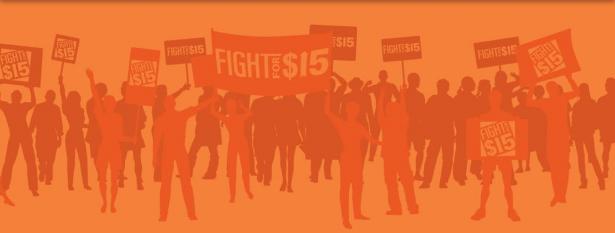The numbers on the effects of raising the federal minimum wage to $15 are all over the map, but newspaper accounts have tended to emphasize those that are flatly wrong, as my colleague David Dayen has documented. The headlines feature the Congressional Budget Office’s estimate of the raise costing 1.4 million jobs. The first paragraphs tend to mention that the CBO’s count of Americans who’d be lifted out of poverty is less than that: 900,000. You have to scroll down to learn that the CBO also finds that the raise would boost the incomes of 17 million Americans, and most probably 27 million Americans—that is, close to a fifth of the entire American workforce.
Let’s unpack those numbers. Seventeen million is the number of our compatriots currently employed at wage levels below the new rising minimum (the raise is phased in over the next four years; the first raise, to $9.50, would take effect next year). The additional ten million workers are those who make just above the minimum, whose wages would almost surely be increased, too. The 900,000 is the number of workers whose income is almost exactly at the level at which we officially designate poverty. A great many poor workers are beneath or above, rather than precisely at, that level, which doesn’t mean that they’re not poor, and does mean they would still see their incomes boosted appreciably by the raise.
As to the 1.4 million, that estimate is 300,000 greater than the CBO’s 2019 estimate, and one that a number of economists who specialize in the minimum wage’s effect believe is too high. It’s worth pointing out that every single hike in the minimum wage has seen some economists predicting it will cost too many jobs, a prediction that dates back to the 1938 enactment of the first federal minimum wage. Of course, since 1938, the number of employed Americans has grown by well over 100 million, despite repeated hikes in the minimum wage. Somehow, despite these serial encroachments on the sanctity of laissez-faire labor markets, we have managed to plod along.
Finally, the CBO also estimates that raising the wage to $15 will raise the federal deficit by $54 billion. Again, you have to scroll down to find that that figure is for ten years. Annualized, it comes to $5.4 billion, out of a total yearly federal budget that’s a little more than $3 trillion, and that is likely to rise over the course of that same next decade. In other words (more precisely, in other numbers), it comes to an increase of about 0.2 percent (if you prefer words, two-tenths of one percent) of federal spending.
The CBO’s numbers focus on such matters as the increased costs to the federal health insurance programs likely to come from such horrors as paying hospital orderlies more. Other economists, led by Michael Reich at UC Berkeley (home to the most empirically grounded economics department), have estimated that the federal deficit will actually shrink as the raise will lead to an increase in federal tax revenues and a decrease in such poverty alleviation programs as food stamps.
Harold Meyerson is editor at large of The American Prospect. His email is hmeyerson@prospect.org.
Thank you for reading The American Prospect. Support our work by becoming a member. Your voluntary contribution helps keep this website paywall-free.
Read the original article at Prospect.org.
Used with the permission. © The American Prospect, Prospect.org, 2021. All rights reserved.


Spread the word